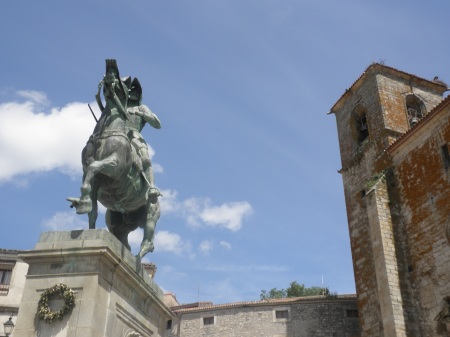“…the breed of men who conquered a continent with a handful of adventurers, wore hair shirts day and night until they stuck to their flesh, and braved the mosquitoes of the Pilcomayo and the Amazon” – Gerald Brenan
The Conquistador, Francisco Pizzaro…
It is a magnificent statue, matched only by that of El Cid in Burgos, and I challenge anyone not to admire it. Here is the gigantic figure of Pizarro astride his proud giant of a horse dominating the entire square of Trujillo, head up, beard jutting and helmet plumes flowing as though trying to stay attached to his armour whilst at full gallop.
The statue captures and epitomises the flare and the audacity of the conquistadores and in his hand he carries a menacing sword but in a message that here was a man who lived and died by the sword the statue has no scabbard which seems to suggest that he rarely ever put the blade away!
Francisco Pizzaro was born in Trujillo and became a conquistador who travelled along much of the Pacific coast of South America. With an army of only one hundred and eighty men and less than thirty horses he encountered the ancient Incan empire and brutally and quickly conquered it, killing thousands of natives, including the Inca King Atahualpa and stealing immense hoards of gold, silver, and other treasures for the King of Spain and for himself including the Inca King’s wife who he took for a mistress.
As a consequence of Pizzaro’s adventures, Spain became the greatest, richest and most powerful country in the world at the time and as well as conquering Peru and founding the city of Lima, he also added Ecuador and Columbia to the Spanish Empire thus providing immense new territories and influence and spreading Roman Catholicism to the New World.




Andrew his hat reminds me of the soldiers we saw in Pisa during a parade. Coincidence?
LikeLike
Hat? Surely you mean helmet! This is a really good statue worth driving to Trujillo to see!
LikeLiked by 1 person
Ok yes helmet would be the technical term. 🙂 There is a photo in this post.
LikeLike
Thanks Sue. Did you climb to the top? I stayed there in a hotel on the river, I am certain that it is in your picture. It was the noisiest hotel room I have ever stayed in (street noise) and had to be moved after the second night.
LikeLiked by 1 person
The tower was closed when we were there Andrew. We only spent the day inPisa on our way to Venice from Cinque Terre. Yikes about the hotel room!
LikeLike
We were lucky, it had just reopened, 2006. It is pretty scary up there but worth it. You need to go back and do it!
LikeLiked by 1 person
On the list Andrew. I’m planning to live till I am 150 to get the list accomplished. 🙂
LikeLike
Or just retire a bit earlier!
LikeLiked by 1 person
Andrew, In all your travels have you ever come across any documentation that explains the significance of the number of feet the horse has on the ground? I remember reading years ago that something was signified such as whether the rider died in battle or lived for longer.
LikeLike
Yes, it apparently started in the USA after the battle of Gettysburg. Two feet off the ground, rider killed in battle, one foot, rider died of wounds sustained in battle, all feet on the ground, the rider died peacefully in bed. Sadly there is no truth in it whatsoever and plenty of examples which disprove the myth!
LikeLike
Thanks!
LikeLike
I am teaching Latin American history this semester, and it is interesting to study how the conquistadors succeeded. There were a ton of factors, but Pizarro was helped by disease. When he came upon the Inca, they were embroiled in a civil war caused by a massive population decline. Foreign diseases traveled faster than foreign people.
LikeLike
Thanks Rick, I’d love to sit in those lectures.
I think Pizarro was most probably a man that you would most likely want to avoid with or without a bad cold.
My favourite bit of Latin American trivia concerns the Treaty of Tordesillas between Spain and Portugal in 1494 where an agreement was signed which gave Brazil to Portugal and all the rest to Spain. This might have seemed like a good idea at the time but it rates as a serious negotiating disaster for Spain as it gave up the Amazon rain forest and all of its riches for the Andes of Patagonia and made Portuguese the most spoken language in South America.
I think you should visit Trujillo.
LikeLike
Victory can be achieved….through audacity and gold lust. In addition to a warring Incan nation and disease, it helped that Pizarro and his small army of conquistadors were mounted on horseback. The Incan army could fight, but not mounted troops, which is probably why the horse gets to be included in the memorial.
LikeLike